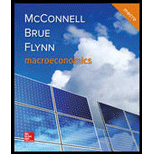
The three basic functions of money.
Explanation of Solution
Money is the item which is mainly used to pay for the economic transactions between the buyers and sellers. Thus, it is the verifiable document which has an intrinsic value. There are mainly three functions of money. The main functions of money are as follows:
Medium of exchange: The money is the important item which facilitates the trade and exchange in the economy. The buyers will accept only money in return to the goods and services that they sell in the market and the consumers will only provide money for the goods and services from the market. It helps to avoid the necessity of double coincidence of wants which might lead to the decline of the barter system. The producers will be willing to offer the product for money and they can use the money for demanding the commodities that they need. Thus, the prime most function of money is the medium of exchange.
Unit of account: The money is used as the unit of account because it is highly liquid and every commodity value can be expressed in terms of the money value. Thus, it acts as a common unit of account in order to express the price of the commodity or service in the economy. Thus, the secondary function of money is the unit of account.
Store of value: Money is also used as the store of value because it retains its value over the time. The money value is retained until it is spent. This helps the money to be used as the store of value for the future. This feature of money is the reason why it is also used as the medium of differed payments in the economy.
When the rapid inflation takes place with very higher rates of inflation, the money value will decline. Too much money will chase too few goods and services from economy. When the rate of inflation is higher than 100 percent or more the money value will be completely lost and there will be no sense in using the money as a medium of exchange as huge amounts that will chase only too small quantities. This will revert the people from the use of money to the use of barter system.
The rapid inflation and the decline in the value of the money will make it difficult to use it as the store of value because those who keep the money with them will lose the value of money and the creditors will be affected due to the inflation. Thus, the rapid inflation will lead to the loss of value of money which will undermine the money's ability to be used as a medium of exchange, or a unit of account as well as the store of value.
Concept introduction:
Money: It is an item or verifiable document that can be accepted as the payment to settle transactions and debt repayment purposes in the economy. The general form of money is the paper currencies as well as the metallic coins.
Inflation: It is the abnormal rise in the general price level of commodities in economy. During the period of inflations, more money is required to purchase goods than before and thus, the
Want to see more full solutions like this?
Chapter 14 Solutions
Macroeconomics
- how commond economies relate to principle Of Economics ?arrow_forwardCritically analyse the five (5) characteristics of Ubuntu and provide examples of how they apply to the National Health Insurance (NHI) in South Africa.arrow_forwardCritically analyse the five (5) characteristics of Ubuntu and provide examples of how they apply to the National Health Insurance (NHI) in South Africa.arrow_forward
- Outline the nine (9) consumer rights as specified in the Consumer Rights Act in South Africa.arrow_forwardIn what ways could you show the attractiveness of Philippines in the form of videos/campaigns to foreign investors? Cite 10 examples.arrow_forwardExplain the following terms and provide an example for each term: • Corruption • Fraud • Briberyarrow_forward
- In what ways could you show the attractiveness of a country in the form of videos/campaigns?arrow_forwardWith the VBS scenario in mind, debate with your own words the view that stakeholders are the primary reason why business ethics must be implemented.arrow_forwardThe unethical decisions taken by the VBS management affected the lives of many of their clients who trusted their business and services You are appointed as an ethics officer at Tyme Bank. Advise the management regarding the role of legislation in South Africa in providing the legal framework for business operations.arrow_forward
 Essentials of Economics (MindTap Course List)EconomicsISBN:9781337091992Author:N. Gregory MankiwPublisher:Cengage Learning
Essentials of Economics (MindTap Course List)EconomicsISBN:9781337091992Author:N. Gregory MankiwPublisher:Cengage Learning Brief Principles of Macroeconomics (MindTap Cours...EconomicsISBN:9781337091985Author:N. Gregory MankiwPublisher:Cengage Learning
Brief Principles of Macroeconomics (MindTap Cours...EconomicsISBN:9781337091985Author:N. Gregory MankiwPublisher:Cengage Learning Macroeconomics: Private and Public Choice (MindTa...EconomicsISBN:9781305506756Author:James D. Gwartney, Richard L. Stroup, Russell S. Sobel, David A. MacphersonPublisher:Cengage Learning
Macroeconomics: Private and Public Choice (MindTa...EconomicsISBN:9781305506756Author:James D. Gwartney, Richard L. Stroup, Russell S. Sobel, David A. MacphersonPublisher:Cengage Learning Economics: Private and Public Choice (MindTap Cou...EconomicsISBN:9781305506725Author:James D. Gwartney, Richard L. Stroup, Russell S. Sobel, David A. MacphersonPublisher:Cengage Learning
Economics: Private and Public Choice (MindTap Cou...EconomicsISBN:9781305506725Author:James D. Gwartney, Richard L. Stroup, Russell S. Sobel, David A. MacphersonPublisher:Cengage Learning
 Principles of Economics (MindTap Course List)EconomicsISBN:9781305585126Author:N. Gregory MankiwPublisher:Cengage Learning
Principles of Economics (MindTap Course List)EconomicsISBN:9781305585126Author:N. Gregory MankiwPublisher:Cengage Learning





